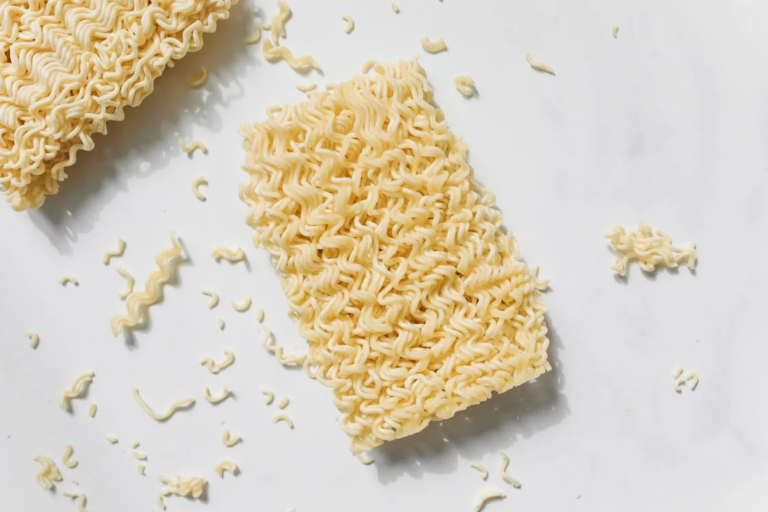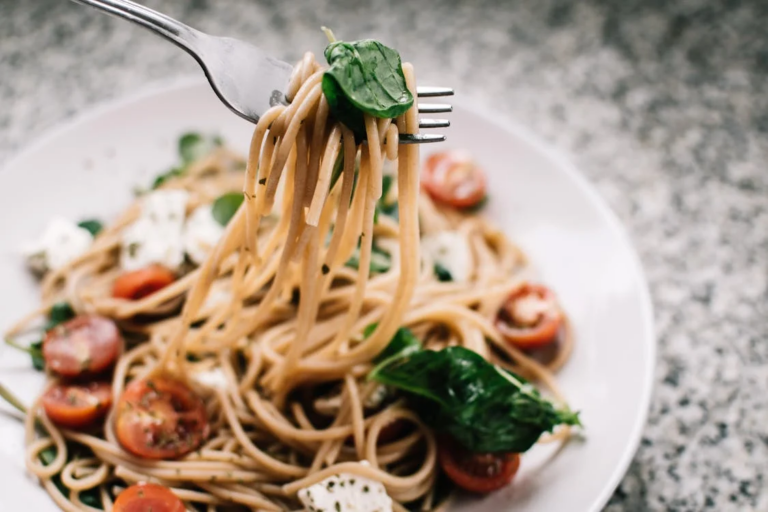Chinese Noodle Types: An All-Inclusive Guide

Which varieties of Chinese noodles are ideal for a multi-dish feast with all of your friends, and which are perfect for a Saturday afternoon (or two in the morning) pick-me-up? Though it may ultimately depend on personal taste, we have some recommendations.
The most common types of noodles, their corresponding sauces and toppings, their preparation methods, and—most importantly—where to find them are all broken down in this guide.
Types of Chinese Noodles
What Are Dan Dan Noodles?
Dan Dan Noodles (担担面) are a spicy specialty that was born in Sichuan but has since taken the world by storm—and for a good reason. They’re the flavor equivalent of a roller coaster. Legend has it that peddlers in Sichuan’s capital, Chengdu, would tie baskets to either end of a bamboo pole (dan, 担). One basket would be filled with noodles (mian, 面) that had a perfectly bouncy chew, while the other would hold a fragrant, spicy chili oil. Thus, this delicious snack got its name.
These noodles have a sesame-based sauce with enough tingly, aromatic spice to serve as the life of the party anywhere they go.
Part of what contributes to the tingly spiciness of this classic is the Sichuan peppercorns and chili oil, combined into a numbing sauce called mala (麻辣) that clings to the noodles. Paired with your choice of either ground pork or Impossible Meat™, Chinese mustard greens, fresh scallions, and peanuts (if you’re into them), it makes for a crunchy, savory, spicy noodle dish that’s beloved in China and beyond.
What Are Scallion Oil Noodles?
Originating in Shanghai in the 18th century, Scallion Oil Noodles (葱油拌面) are a vegetarian’s delight and a point of culinary pride for the city, featuring thin, springy noodles and a sophisticated umami sauce.
While they may seem humble, these slender, wheat-based noodles are the kid you knew in your small-town high school who traveled around the world and came back seasoned with experience, all without forgetting his roots.
In other words, Scallion Oil Noodles are a delicately flavored unsung hero of Shanghai that has become a can’t-miss experience for the port town.
We make our Scallion Oil Noodles with simmered fresh green onions, soy sauce, and oil to create a captivating deeply flavored umami experience. Paired with thin, straight noodles made with the sun-drying method in Guanmiao, Taiwan, they make for a delightfully savory experience that will take your taste buds on a flavor journey.
Scallion Oil Noodles are also the perfect vehicle to serve as a side with other dishes or toppings—so go wild with your favorite spicy or sour dishes, because these noodles work well with others.
What Are Zha Jiang Noodles?
This is a noodle by many names. Also known as Sweet & Savory Noodles or zha jiang noodles, our Zhá Jiàng Miàn (炸酱面), are made with a rich, soybean-based sauce that tastes like a warm hug. However, there are other sauces that go into this fried sauce and noodle dish—for example, some options include spicy chili bean paste, called doubanjiang (豆瓣酱), or black bean-based sauces like tianmian sauce (甜面酱), among others.
Originating in Beijing, these noodles started out as a popular snack for soldiers in the 19th century before quickly spreading to the rest of the country and beyond, developing multiple variations wherever they went. We like to follow the OG style for Beijing, which is known for being an aromatic experience with savory, complex flavors.
The sauce for Zhá Jiàng Miàn is made with premium dark soy sauce and fermented soybean paste. It’s usually paired with your protein of choice—we especially like it with ground pork or Impossible Meat™. To add an extra level of freshness that balances out all the savory and umami goodness, we recommend garnishing it with thinly sliced carrots and cucumbers.
Aside from the savory-sweet sauce, what sets Zhá Jiàng Noodles apart are the fresh, slightly thicker wheat noodles. These have a delightfully chewy, bouncy texture that serves as the perfect vehicle for this substantial sauce.
What Is Beef Noodle Soup?
On its most basic level, beef noodle soup ( 牛肉面) is a hearty, savory soup made with beef stewed in broth for hours, thick noodles, and occasionally pickled cabbage or Chinese mustard as a topping. Since it tastes like a warm, comforting solution to rainy days, sick days, or days when you’re just not feeling like yourself, it’s become one of the most popular dishes in Taiwan and is gaining a foothold in other countries as well.
Thought to have started in Sichuan, beef noodle soup used to have a serious, mala-style spicy kick. However, like many of us, it mellowed out with age—settling in Taiwan, the most recognizable recipe still has a bit of a bite to it, but the broth is mainly soy-based and thus has more of an umami flavor than its Sichuan-based forefather.
The types of noodles used in beef noodle soup can vary depending on who’s cooking. In most cases, they tend to skew thicker and are almost always wheat-based. They can also be either dried or fresh, depending on preference. This allows the broth to cling to the noodles with ease, without the noodles breaking apart under pressure like us before finals in our first year of college.
What Is Liangpi?
Literally translated as “cold skin,” liangpi (凉皮) are thick, chewy, and translucent noodles; hence the name. A specialty of Shaanxi Province, they’re served cold and come in a variety of widths, all of which are delicious any time of year despite the way they’re served, even in the depths of winter.
Just like that black shirt your mom bought for you a few years ago, liangpi are versatile enough to go with almost anything. Some variations include serving them with garlic and hot chili oil, garnishing them with cucumber and a sesame-based sauce, or served with mianjin wheat gluten and hot chili oil.
What Is Lo Mien?
Sometimes spelled “lo mein,” lo mien (捞面) is a wheat and egg-based specialty from Guangdong that has become a worldwide superstar with a lot of culinary flexibility. A frequent feature in fried noodle dishes by the same name, they have a springy, firm texture—perfect either for a quick lunch or at 3 a.m. after a night of mischief.
They’re also frequently paired with meats like chicken, pork, or beef, and occasionally seafood, along with a nearly endless array of vegetable options depending on what you like or have sitting in the refrigerator.
The fried noodles get their umami-packed flavor from the savory sauce added in at the end of the cooking process, which can feature sesame oil and soy sauce, plus oyster sauce for the non-vegetarians among us.
What Is Wonton Noodle Soup?
Wonton noodle soup (云吞面) is a Cantonese carb lover’s dream come true. Featuring thin, chewy egg noodles and filled wontons in a chicken- or pork-based broth, this soup has a clean flavor that is beloved in its home region of Guangdog, in Southeast Asian countries, and beyond.
Like many Chinese dishes, there are multiple regional variations, both in what goes into the wontons and the types of toppings and garnishes used. Some areas, like Guangzhou and Hong Kong, use mainly shrimp in their wontons, while other cities in or near Guangdong use pork, shrimp, mushrooms, and other fillings.
Some people also prefer to top the soup with Chinese broccoli, or gai lan (芥兰), and other leafy vegetables, spring onions, and other toppings where the soup is eaten in Southeast Asia.
What Are Glass Noodles?
Sometimes called fensi (粉丝) or cellophane noodles, glass noodles are thin, semi-transparent noodles. Frequently made of mung bean, tapioca, or sweet potato starch, these noodles start as being brittle and hard. But, like a mom on a hard-earned spa retreat, they soften up and take on a bright, shiny appearance after being soaked in hot water. From there, the noodles can be used to cook a huge range of dishes.
Glass noodles are the star of the show in Sichuan dishes like Ants Climbing a Tree (蚂蚁上树), where they are paired with ground meat to invoke an image of ants climbing up a tree’s long vines and branches.
However, as a worldwide phenomenon, glass noodles went abroad. Versions of glass noodles have made their way into Vietnamese soups like miến lươn, Thai salads like yam wun sen (ยำวุ้นเส้น), and nostalgic Chinese-Hawaiian sick day meals like chicken long rice.
What Are Biang Biang Noodles?
A specialty of Shaanxi cuisine, biang biang noodles (𰻝𰻝面—or 油泼扯面 if you don’t have much time to write out the full character twice) are understated and elegant, having started out as a workers’ meal before becoming popular in elegant restaurants across China.
Featuring the best flavors from Shaanxi and some elements of Sichuan cuisine, biang biang noodles are thick and chewy, thanks to being broad and long. They’re also topped with a fragrant, garlicky chili oil and black vinegar that makes for a spicy, savory, tangy experience like no other.
What Are Hand-Pulled Noodles?
The OG version and inspiration for the instant ramen that got you through your college years, lamian (拉面) are hand-pulled wheat noodles that are especially popular in soups and stir-fries.
Making lamian requires some finesse, and some chefs spend years perfecting their various techniques. They will typically fold, stretch, and pull the dough until it’s almost as long as their arm span, sometimes waving their arms while holding it and slamming it into the table as hard as they can to achieve the perfect chewy texture.
Hand-pulled noodles come in multiple widths and shapes, including broader and narrower varieties, depending on who’s cooking and how many times they fold and pull the dough when they’re making it.
How Different Types of Chinese Noodles Are Made

Ingredients: What Chinese Noodles Are Made of
There are dozens upon dozens of varieties of Chinese noodles to be found, many of which are made with different ingredients. Some are made of rice flour, mung bean starch, or sweet potato starch. Some are sold dried, while others are refrigerated and sold either fresh or frozen.
As the name implies, egg noodles are made with both flour and eggs, which gives them a bright yellow color and a slightly heavier texture than their flour-only counterparts.
However, most of the noodles we specialize in at MìLà are made of wheat. We prepare noodles both fresh and dried, and ship them to you with an insulated liner, so they stay fresh when they arrive.
Cutting Noodles for the Perfect Flavor Experience
You may be wondering, why do we use one type of noodle for our Dan Dan and Scallion Oil Noodles, but a different kind for our Sweet & Savory variety? While all noodles are equal in their deliciousness, there are some differences in preparation that impact the flavor experience—which is also the case for our Chinese noodles.
Some noodles, such as lamian, are long and thin while still maintaining a robust, springy texture when prepared by grandmas and other experts. These can be straight, wavy, or even curly, each imparting a slightly different flavor experience.
There are also knife-cut noodles (刀削麵), which are thicker, chewier, and ribbon-shaped by design and typically cut off large blocks of dough.
In our Chinese noodle dishes, we use two different types and shapes. Our Dan Dan Noodles and Scallion Oil Noodles are thin and straight, while our Sweet & Savory Noodles use the thicker Yang Chun-style preparation.
How They Pair with Sauce Flavors
The reason behind our usage of these different varieties ultimately boils down (pun fully intended) to how the sauce clings to the noodles as a vehicle.
Because our Dan Dan and Scallion Oil Noodles use thinner, oil-based sauces, they pair beautifully with our thin, straight noodles, so every strand gets an even coating of the delicious, tingly spicy or umami sauce.
On the other hand, our sweet and savory noodles have a heavier sauce and thus call for a thicker noodle with a bit more heft. We chose them because they make the perfect vehicle for your flavor journey, easily picking up the fermented soybean-based sauce and any vegetables or protein with ease.
Proteins That Pair with Chinese Noodles
To add an extra savory layer to an already multifaceted experience, Sichuan Dan Dan Noodles are traditionally paired with ground pork as part of the sauce. Similarly, Sweet & Savory Noodles are also paired with ground pork that complements the salty-sweet soybean past sauce—however, it’s not unheard of to use extra firm tofu, omelet, or other types of minced meat like chicken or beef. There’s nothing quite like the OG though, so we like to get saucy with ground pork.
Need a plant-based option instead? No problem. We also offer Impossible™ Meat for the same savory taste, all with plant-based protein that tastes just as authentic.
On the other hand, Shanghai Scallion Oil Noodles are vegan and typically don’t contain any extra protein. While you might opt to serve some vegetable or mushroom dishes alongside the noodles as part of a larger meal, we recommend letting that rich umami sauce be the main event.
Where to Buy Chinese Noodles
The easiest route to an authentic experience with Chinese wheat noodles is to order them from MìLà. Even if you live on the other side of the U.S. from our local production facilities in Monterey Park, Calif., or Auburn, Wash., we have a Melt-Free Guarantee—your Chinese noodles will be shipped frozen to your door, wrapped in an insulated liner that keeps them fresh before they get there.
Once they’ve arrived, you’re just 10 minutes away from enjoying fresh Chinese noodles. Simply bring 8 cups of water to a rolling boil and heat the unopened sauce packet for 4 minutes before taking it out.
Then, in the same pot of boiling water, add the noodles and stir them around for 6 minutes to keep them from sticking to the bottom of the pot. Once time is up, drain the noodles and stir them together with the sauce and any proteins or vegetables you want to add to the mix, then get ready to take your taste buds to a night market in Shanghai.



